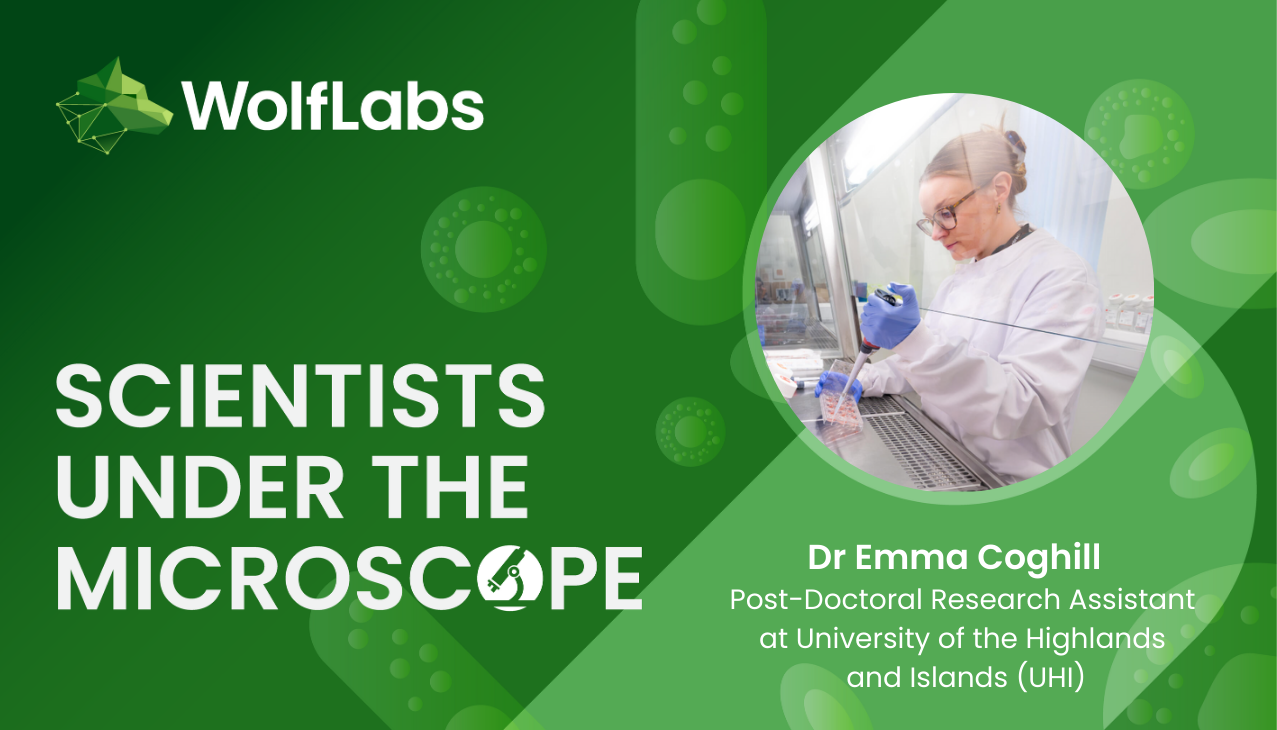
Scientists Under the Microscope with Emma Coghill
WolfLabs is putting Scientists under the microscope!
This time, we’re featuring Emma Coghill, a Laboratory Research Assistant at the University of the Highlands and Islands.
1. Tell us about the research you’re doing.
My research focuses on the biological evaluation of novel nitric oxide (NO) releasing nanoporous materials designed for use in blood-contacting medical devices, such as catheters, vascular sheaths, and PICC lines. I’m assessing their overall biocompatibility and cytotoxicity, as well as their functional performance. This includes studying their ability to promote vasodilation using myography, measuring nitric oxide (NO) release in biological solutions over time, and investigating how they influence platelet behaviour — both in terms of inhibiting activation and reducing adhesion. Together, these studies aim to determine whether these materials can reduce common complications like thrombosis and vasospasm, ultimately improving the safety and performance of intravascular devices.
2. What made you interested in this area of research?
I first became interested in this area during my master’s degree, when I carried out a short research project on these materials. That initial exposure led me to pursue a PhD focused on their vascular interactions and potential to improve blood-contacting devices. Now, in my career, I continue to develop this work, while also aiming to expand my research into broader biomedical applications.
3. What has been your biggest challenge so far?
My biggest challenge has been adapting standard biological assays, which are normally designed for drugs in solution, to test solid materials. Early on I realized that a lot of the equipment — like the myograph or platelet aggregometer — simply wasn’t built for this kind of work. That meant I had to get creative, designing ways to insert tubing materials into artery segments, add them into platelet suspensions without disrupting light transmission, and even adapt cell assays to check for cytotoxicity. At times it was frustrating, but it really brought out my problem-solving side, and in the end it was very rewarding to see these new methods work and open the door for continued material testing.
4. What outcome are you hoping to achieve?
So far, our testing has been very successful, and the materials are showing great promise in improving the safety of blood-contacting devices. The main challenge now is storage, as their efficacy decreases over time, but we’re making good progress in finding ways to overcome this. Addressing this issue is essential for their use in longer-term devices like PICC lines, and it’s an exciting focus for the whole collaborative team as we move closer to translating these materials into real-world applications.
5. Do you have any advice for those wanting to get into your field?
My advice would be that biomedical research is challenging, and outcomes are not always certain, but it can be incredibly rewarding. If you enjoy problem-solving, thinking creatively, and tackling complex questions, it’s a field where your work has the potential to make a real difference for patients. Persistence, curiosity, and a willingness to learn from setbacks are key, and collaborating with others across different disciplines will enrich your experience and your research.
6. What plans do you have for your research over the next 5 years?
To be honest, I’m not entirely certain — academic research is unpredictable at the moment, so it’s hard to know exactly what the next five years will hold. What I do know is that I want to continue working on something meaningful, regardless of the scientific discipline. I’d love to gain experience across different fields, and in terms of this specific work, it’s incredibly exciting for the team. I hope it continues to develop, and I will always feel proud to have played a part in it.
7. Which member of The Big Bang Theory are you most like?
Honestly, I’m probably most like Penny in spirit — I spend my free time at the gym and doing sporty activities, and I don’t think about science at all outside of work. I think people are often really surprised to learn I have a PhD and work in research, but I like it that way!
Would you like to feature in our Scientist Under The Microscope articles? Send your answers to Sales@wolflabs.co.uk
